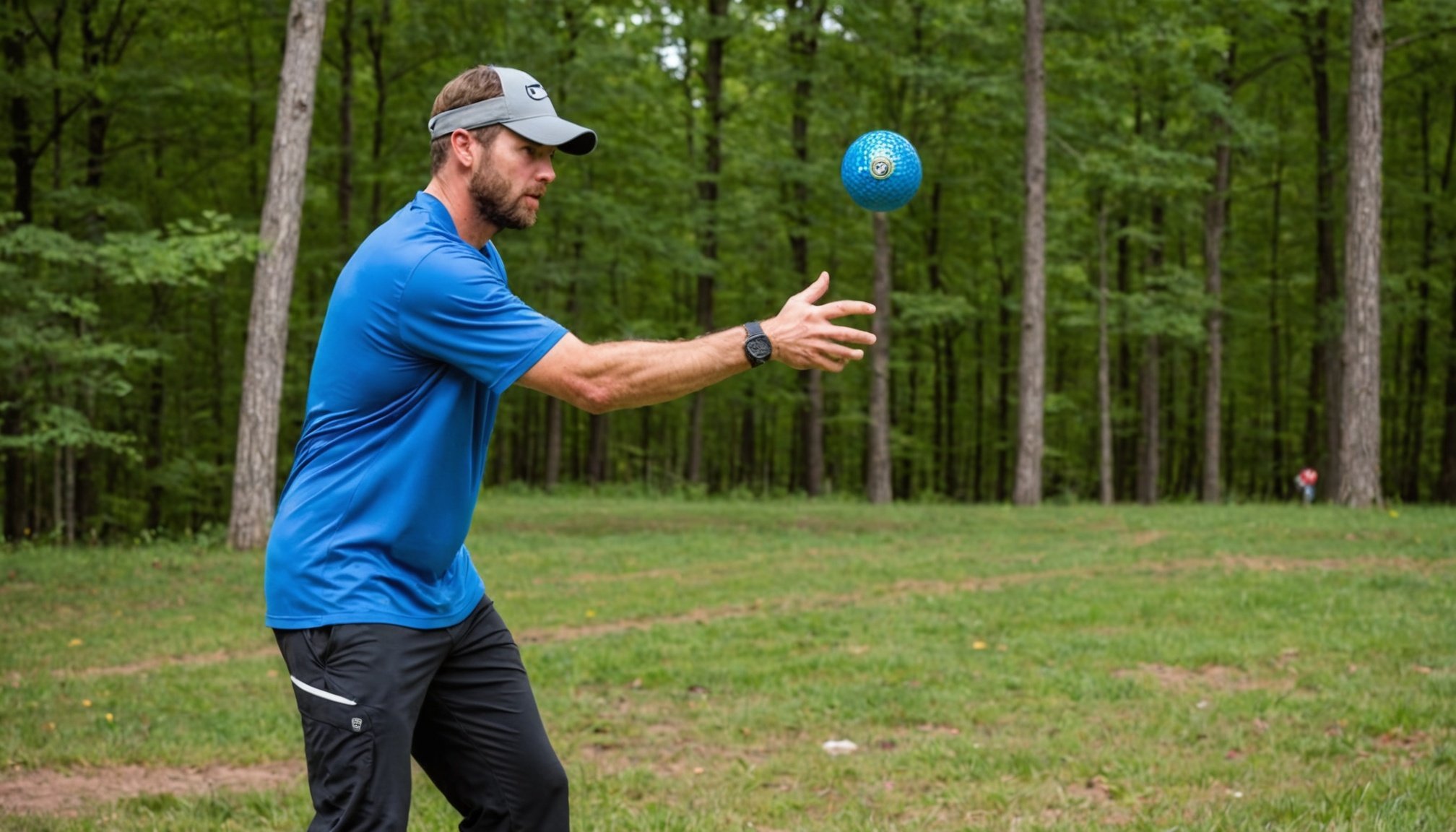Advanced Grip Techniques for Disc Golf
In the world of disc golf, mastering grip techniques can dramatically enhance your performance. Professionals often adapt different grip styles to match their unique playing strategies, which significantly influence the precision of their throws. The amount of grip pressure applied is a critical factor that impacts throw accuracy and control. Gripping too tightly can lead to tension that affects release, whereas a grip that’s too loose may compromise throw speed and control.
Hand Positioning
Grip styles vary not just in pressure, but also in hand positioning, which diverges notably between forehand and backhand throws. For forehand throws, players typically position fingers under the disc for stability, whereas backhand throws involve cradling the rim with fingers for a tighter spin. Understanding these nuanced differences can refine your throw precision and adaptability in changing field conditions. Implementing variations in grip style, pressure, and positioning can yield better performance outcomes, encouraging players to experiment with these aspects to find their optimal grip technique.
Topic to read : Master Your Golf Game: Harness Biomechanical Insights to Enhance Performance and Prevent Injuries for Amateur Players
Each player should practice to discover their ideal grip, as the balance of grip styles and pressure can lead to a significant improvement in overall gameplay.
Finger Placement Strategies
In disc golf, finger placement plays a pivotal role in ensuring grip stability while optimizing the mechanics of your throw. Mastering the nuanced strategies of where and how to position your fingers can drastically influence your performance on the disc golf course.
Also to discover : Master Pro-Level Training Techniques to Stay Ahead of the Game
Optimal Finger Positions for Various Throws
Different throws necessitate distinct finger placements for ideal outcomes. For instance, in backhand throws, placing the index and middle fingers under the rim can increase spin, aiding in both flight control and distance. Conversely, forehand throws often involve using the thumb on top and two fingers underneath for grip stability and precision.
Common Mistakes in Finger Placement
Avoid common pitfalls such as overextending fingers which can hamper control, or using a one-size-fits-all approach that ignores the unique dynamics of each throw type. Recognizing these mistakes can help refine your grip technique, allowing for more consistent throws.
Drills to Improve Finger Dexterity
Incorporating finger-specific drills can boost dexterity and strength. Simple exercises like squeezing a stress ball or finger stretches can elevate finger coordination, ultimately enhancing your grip technique and overall gameplay. Practicing these drills regularly is essential for maintaining consistent finger placement and improving throwing mechanics.
Grip Pressure and Control
Achieving the right balance in grip pressure is vital to mastering throw control and ensuring precision accuracy in disc golf. Grip pressure plays a crucial role in determining the angle and release speed of your throw. Holding the disc too tightly can lead to tension, which may disrupt the smooth release and cause inaccurate throws. Conversely, a grip that’s too loose often results in compromised disc speed and control, diminishing overall performance.
Finding your ideal grip pressure requires consistent practice and experimentation. Begin by testing varying grip pressures to understand their effects on your throw. Observe how different pressures influence the disc’s release angle and adjust accordingly to optimise accuracy. One useful approach is to practice throws with a medium-tight grip, gradually adjusting until you achieve the desired control.
To hone in on your personal sweet spot for grip, try incorporating specific drills. For example, practice controlled throws at a target with different grip tensions to experience the direct impact on throw dynamics. These adjustments can foster better handling, leading to improved game performance over time.
Comparative Analysis of Throwing Styles
Exploring different throwing styles in disc golf can provide insight into the subtle dynamics between grip techniques and performance outcomes. Professional players often debate the merits of their preferred throw styles, creating a varied landscape of strategies.
Forehand vs Backhand: Grip Differences
The most common throwing styles, forehand and backhand, each possess distinctive grip techniques that can significantly affect throwing dynamics. For a forehand throw, players typically leverage a grip that involves the thumb on top and fingers underneath the disc, helping control spin and stability. Conversely, backhand throws require a grip where the index finger is under the rim, crucial for generating speed and flight control.
Hyzer vs Anhyzer Grip Techniques
Understanding hyzer and anhyzer throws enhances gameplay adaptation. A hyzer grip involves holding the disc at a slight angle upon release to achieve a curve, ideal for navigating bends and wind resistance. Anhyzer, on the other hand, relies on an upward angle for more dynamic flight paths, often utilized in challenging courses with obstacles.
Evaluating Performance Based on Grip Styles
Players should evaluate their performance by experimenting with different grip styles and observing the resultant throw dynamics. Insights gained from these analyses can inform adjustments and personal preferences, leading to enhanced precision and crafted strategies.
Drills to Enhance Grip Strength and Precision
Effective grip training can dramatically improve your disc golf performance. Incorporating specific drills into your routine not only boosts strength but also enhances throwing precision.
Targeted Grip Strength Drills
- Isometric Holds: Increase hand endurance by clenching and holding a disc tightly.
- Finger Bands: Use rubber bands to strengthen hand muscles by spreading fingers apart.
These exercises help build the necessary strength for maintaining consistent grip under varying field conditions.
Practicing Grip Consistency
To maintain grip consistency, practice throwing under simulated pressure. Vary the types of throws—forehands, backhands, hyzers, and anhyzers—to adapt your grip to different scenarios. This routine improves grip reliability, translating into more stable performance during actual games.
Integrating Grip Drills into Training
Incorporate these drills into your regular training sessions, aiming for at least a few minutes of focused grip exercise each time. Not only does it enhance overall grip strength, but it also keeps your technique crisp and responsive. Consistent training ensures that precision enhancement becomes a seamless part of your disc golf skill set.
Visual Aids and Resources
Understanding and mastering grip techniques in disc golf can be significantly enhanced through the use of visual aids and resources. Effective resources offer a visual guide to demonstrate correct hand positioning, grip pressure, and throwing mechanics, providing a clearer understanding for both beginners and seasoned players.
Diagrams Illustrating Grip Techniques
Diagrams are pivotal for learning precise grip techniques. They meticulously detail hand positioning for various throws, showing the crucial differences in forehand and backhand grips. Visual step-by-step guides can bridge the gap between theoretical knowledge and practical application, helping players perfect their techniques.
Recommended Video Tutorials by Professionals
Video tutorials from professional players provide a dynamic learning medium, illustrating grip techniques in action. By watching seasoned players execute perfect throws, enthusiasts can glean tips on achieving a more refined grip. Such content often highlights how slight adjustments in hand positioning or grip pressure can impact throw dynamics.
Books and Articles on Disc Golf Grip Mechanics
Incorporating comprehensive books and articles into one’s training routine can deeply enrich understanding of disc golf mechanics. These resources frequently offer a blend of advanced technical advice and personal anecdotes, supporting learners in their quest to master grip techniques and elevate their disc golf performance.











